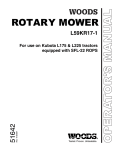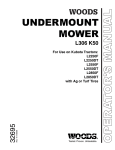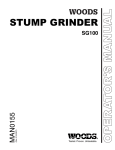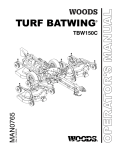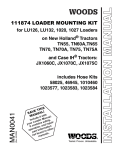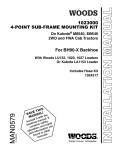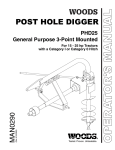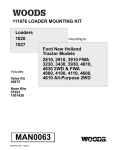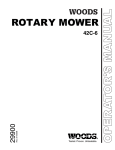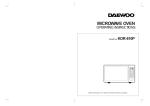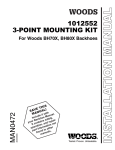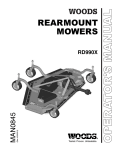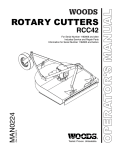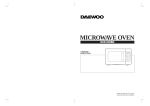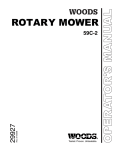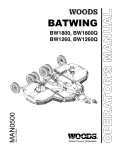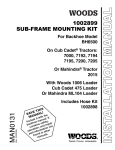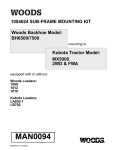Download Woods Equipment L306A-3 User's Manual
Transcript
L59A-3 L306A-3 Rev. 2/9/2007 15148 For use on International Harvester A, Super A, 100, 130 & 140 Tested. Proven. Unbeatable. OPERATOR'S MANUAL ROTARY MOWER TO THE DEALER: Assembly and proper installation of this product is the responsibility of the Woods® dealer. Read manual instructions and safety rules. Make sure all items on the Dealer’s Pre-Delivery and Delivery Check Lists in the Operator’s Manual are completed before releasing equipment to the owner. The dealer must complete the Product Registration included with the Operator’s Manual. The customer must sign the registration which certifies that all Dealer Check List items have been completed. The dealer is to return the prepaid postage portion to Woods, give one copy to the customer, and retain one copy. Failure to complete and return this card does not diminish customer’s warranty rights. TO THE OWNER: Read this manual before operating your Woods equipment. The information presented will prepare you to do a better and safer job. Keep this manual handy for ready reference. Require all operators to read this manual carefully and become acquainted with all adjustment and operating procedures before attempting to operate. Replacement manuals can be obtained from your dealer. To locate your nearest dealer, check the Dealer Locator at www.WoodsEquipment.com, or in the United States and Canada call 1-800-319-6637. The equipment you have purchased has been carefully engineered and manufactured to provide dependable and satisfactory use. Like all mechanical products, it will require cleaning and upkeep. Lubricate the unit as specified. Observe all safety information in this manual and safety decals on the equipment. For service, your authorized Woods dealer has trained mechanics, genuine Woods service parts, and the necessary tools and equipment to handle all your needs. Use only genuine Woods service parts. Substitute parts will void the warranty and may not meet standards required for safe and satisfactory operation. Record the model number and serial number of your equipment in the spaces provided: Model: _______________________________ Date of Purchase: _____________________ Serial Number: (see Safety Decal section for location) ____________________________________ Provide this information to your dealer to obtain correct repair parts. Throughout this manual, the term IMPORTANT is used to indicate that failure to observe can cause damage to equipment. The terms CAUTION, WARNING, and DANGER are used in conjunction with the Safety-Alert Symbol (a triangle with an exclamation mark) to indicate the degree of hazard for items of personal safety. 2 Introduction Gen’l (Rev. 2/5/2007) TABLE OF CONTENTS INTRODUCTION . . . . . . . . . . . . . . . . . . . . . . . . . . . . . . . . . . . . . . . . . . . . . . 2 SPECIFICATIONS. . . . . . . . . . . . . . . . . . . . . . . . . . . . . . . . . . . . . . . . . . . . . 4 GENERAL INFORMATION . . . . . . . . . . . . . . . . . . . . . . . . . . . . . . . . . . . . . . 4 SAFETY RULES . . . . . . . . . . . . . . . . . . . . . . . . . . . . . . . . . . . . . . . . . . . . . . 5 SAFETY DECALS . . . . . . . . . . . . . . . . . . . . . . . . . . . . . . . . . . . . . . . . . . . . . 7 OPERATION . . . . . . . . . . . . . . . . . . . . . . . . . . . . . . . . . . . . . . . . . . . . . . . . . 8 OWNER SERVICE . . . . . . . . . . . . . . . . . . . . . . . . . . . . . . . . . . . . . . . . . . . 12 DEALER SERVICE . . . . . . . . . . . . . . . . . . . . . . . . . . . . . . . . . . . . . . . . . . . 15 TROUBLESHOOTING . . . . . . . . . . . . . . . . . . . . . . . . . . . . . . . . . . . . . . . . 17 ASSEMBLY . . . . . . . . . . . . . . . . . . . . . . . . . . . . . . . . . . . . . . . . . . . . . . . . . 19 DEALER CHECK LISTS . . . . . . . . . . . . . . . . . . . . . . . . . . . . . . . . . . . . . . . 26 PARTS LISTS . . . . . . . . . . . . . . . . . . . . . . . . . . . . . . . . . . . . . . . . . . . . . . . 31 BOLT TORQUE CHART . . . . . . . . . . . . . . . . . . . . . . . . . . . . . . . . . . . . . . . 45 BOLT SIZE CHART & ABBREVIATIONS . . . . . . . . . . . . . . . . . . . . . . . . . . 46 INDEX . . . . . . . . . . . . . . . . . . . . . . . . . . . . . . . . . . . . . . . . . . . . . . . . . . . . . 47 REPLACEMENT PARTS WARRANTY . . . . . . . . . . . . . . . . . . . . . . . . . . . . 48 PRODUCT WARRANTY . . . . . . . . . . . . . . . . . . . . . . . INSIDE BACK COVER ! LEA EL INSTRUCTIVO! Si no lee Ingles, pida ayuda a alguien que si lo lea para que le traduzca las medidas de seguridad. 15148 (Rev. 2/9/2007) Introduction 3 SPECIFICATIONS MODEL L59A-3 L306A-3 Cutting Width 60" 72" Cutting Height Range 1-1/2" - 4-1/4" 1-1/2" - 4-1/4" Blade Speed (RPM) 2,786 2,173 Blade Tip Speed (feet per minute) 14,770 13,938 Blade Spindles 3 3 Number of Blades 3 3 Caster Wheels Optional Optional Caster Size 3" x 8-1/2" 3-1/4" x 10-1/2" Mower Frame Thickness 7 GA 7 GA GENERAL INFORMATION The purpose of this manual is to assist you in operating and maintaining your mower. Read it carefully. It furnishes information and instructions that will help you achieve years of dependable performance. These instructions have been compiled from extensive field experience and engineering data. Some information may be general in nature, due to unknown and varying operating conditions. However, through experience and these instructions, you should be able to develop procedures suitable to your particular situation. WARNING The illustrations and data used in this manual were current at the time of printing. However, due to possible inline production changes, your machine may vary slightly in detail. We reserve the right to redesign and change the machines as may be necessary without notification. Throughout this manual, references are made to right and left directions. These are determined by standing behind the tractor facing the direction of forward travel. Blade rotation is counter-clockwise as viewed from the top of the mower. ■ Some illustrations in this manual show the mower with safety shields removed to provide a better view. The mower should never be operated with any safety shielding removed. 4 Introduction 15148 (Rev. 2/9/2007) SAFETY RULES ATTENTION! BECOME ALERT! YOUR SAFETY IS INVOLVED! Safety is a primary concern in the design and manufacture of our products. Unfortunately, our efforts to provide safe equipment can be wiped out by an operator’s single careless act. In addition to the design and configuration of equipment, hazard control and accident prevention are dependent upon the awareness, concern, judgement, and proper training of personnel involved in the operation, transport, maintenance, and storage of equipment. It has been said, “The best safety device is an informed, careful operator.” We ask you to be that kind of operator. TRAINING Safety instructions are important! Read all attachment and power unit manuals; follow all safety rules and safety decal information. (Replacement manuals and safety decals are available from your dealer. To locate your nearest dealer, check the Dealer Locator at www.WoodsEquipment.com, or in the United States and Canada call 1-800-3196637.) Failure to follow instructions or safety rules can result in serious injury or death. If you do not understand any part of this manual and need assistance, see your dealer. Know your controls and how to stop engine and attachment quickly in an emergency. Operators must be instructed in and be capable of the safe operation of the equipment, its attachments, and all controls. Do not allow anyone to operate this equipment without proper instructions. Never allow children or untrained persons to operate equipment. PREPARATION Check that all hardware is properly installed. Always tighten to torque chart specifications unless instructed otherwise in this manual. Always wear relatively tight and belted clothing to avoid getting caught in moving parts. Wear sturdy, rough-soled work shoes and protective equipment for eyes, hair, hands, hearing, and head; and respirator or filter mask where appropriate. Make sure attachment is properly secured, adjusted, and in good operating condition. Remove accumulated debris from this equipment, power unit, and engine to avoid fire hazard. L59A-3 & L306A-3 Safety Rules (Rev. 1/12/2007) Make sure all safety decals are installed. Replace if damaged. (See Safety Decals section for location.) Make sure shields and guards are properly installed and in good condition. Replace if damaged. Inspect and clear area of stones, branches, or other hard objects that might be thrown, causing injury or damage. OPERATION You may not be able to stop the tractor safely if the clutch or brake pedal mechanisms are improperly adjusted, allowing them to contact mower components. When the mower lift stops are installed as instructed in this manual, properly adjusted clutch and brake pedal mechanisms will not contact mower components. You should frequently check that the tractor clutch and brake pedal mechanisms are in adjustment. If the clutch or brake pedal mechanisms can contact mower components, do not put mower into service until properly adjusted. Do not put mower into service unless discharge chute is installed and in good condition. Replace if damaged. Keep bystanders away from equipment. Do not operate or transport equipment while under the influence of alcohol or drugs. Never direct discharge toward people, animals, or property. Operate only in daylight or good artificial light. Keep hands, feet, hair, and clothing away from equipment while engine is running. Stay clear of all moving parts. Always comply with all state and local lighting and marking requirements. Never allow riders on power unit or attachment. Always sit in power unit seat when operating controls or starting engine. Place transmission in neutral, engage brake, and ensure all other controls are disengaged before starting power unit engine. Look down and to the rear and make sure area is clear before operating in reverse. Do not operate or transport on steep slopes. Safety 5 SAFETY RULES ATTENTION! BECOME ALERT! YOUR SAFETY IS INVOLVED! Do not stop, start, or change directions suddenly on slopes. Use extreme care and reduce ground speed on slopes and rough terrain. Watch for hidden hazards on the terrain during operation. Stop power unit and equipment immediately upon striking an obstruction. Turn off engine, remove key, inspect, and repair any damage before resuming operation. TRANSPORTATION Always comply with all state and local lighting and marking requirements. Never allow riders on power unit or attachment. Do not operate PTO during transport. Watch for hidden hazards on the terrain. Do not operate or transport on steep slopes. Do not operate auxiliary hydraulics during transport. Do not operate or transport equipment while under the influence of alcohol or drugs. MAINTENANCE Before dismounting power unit or performing any service or maintenance, follow these steps: disengage power to equipment, lower the 3-point hitch and all raised components to the ground, operate valve levers to release any hydraulic pressure, set parking brake, stop engine, remove key, and unfasten seat belt. Do not modify or alter or permit anyone else to modify or alter the equipment or any of its components in any way. Always wear relatively tight and belted clothing to avoid getting caught in moving parts. Wear sturdy, rough-soled work shoes and protective equipment for eyes, hair, hands, hearing, and head; and respirator or filter mask where appropriate. Never go underneath equipment (lowered to the ground or raised) unless it is properly blocked and secured. Never place any part of the body under- 6 Safety neath equipment or between moveable parts even when the engine has been turned off. Hydraulic system leak down, hydraulic system failures, mechanical failures, or movement of control levers can cause equipment to drop or rotate unexpectedly and cause severe injury or death. Follow Operator's Manual instructions for working underneath and blocking requirements or have work done by a qualified dealer. Make sure attachment is properly secured, adjusted, and in good operating condition. Keep all persons away from operator control area while performing adjustments, service, or maintenance. Make certain all movement of equipment components has stopped before approaching for service. Frequently check blades. They should be sharp, free of nicks and cracks, and securely fastened. Do not handle blades with bare hands. Careless or improper handling may result in serious injury. Your dealer can supply genuine replacement blades. Substitute blades may not meet original equipment specifications and may be dangerous. Tighten all bolts, nuts, and screws to torque chart specifications. Check that all cotter pins are installed securely to ensure equipment is in a safe condition before putting unit into service. Make sure all safety decals are installed. Replace if damaged. (See Safety Decals section for location.) Make sure shields and guards are properly installed and in good condition. Replace if damaged. Wear gloves when installing belt. Be careful to prevent fingers from being caught between belt and pulley. STORAGE Block equipment securely for storage. Keep children and bystanders away from storage area. L59A-3 & L306A-3 Safety Rules (Rev. 1/12/2007) SAFETY & INSTRUCTIONAL DECALS ATTENTION! BECOME ALERT! YOUR SAFETY IS INVOLVED! Replace Immediately If Damaged! 3 - Serial Number Plate MODEL NO. SERIAL NO. Woods Equipment Company Oregon, Illinois, U.S.A. 1 - 25505 2 - 53425 DANGER ROTATING BLADES AND THROWN OBJECTS Do not put hands or feet under or into mower when engine is running. Before mowing, clear area of objects that may be thrown by blade. Keep bystanders away. Keep discharge chute and guards in place and in good condition. BLADE CONTACT OR THROWN OBJECTS CAN CAUSE SERIOUS INJURY OR DEATH. 53425-B 4 - 18869 SHIELD MISSING DO NOT OPERATE - PUT SHIELD ON 15148 (Rev. 2/9/2007) 18869-B DANGER Safety 7 OPERATION A ADJUSTMENTS WARNING Cutting Height Adjustment ■ Do not allow children or unqualified persons to operate equipment. ■ Keep bystanders away from equipment while it is in operation. NOTICE ■ ■ Avoid very low cutting heights. Striking the ground with blades produces one of the most damaging shock loads a mower can encounter and, if this happens repeatedly, will cause damage to the mower and drive. ■ Mower cutting height is raised and lowered with a manual or hydraulic lift. It may be adjusted using optional caster wheels, push bar and channel arm settings. Before working underneath, block mower securely. Hydraulic system leak down and failure of mechanical or hydraulic system can cause equipment to drop. Keep all persons away from operator control area while performing adjustments, service or maintenance. With Lift Chains A CAUTION ■ Stop mower and tractor immediately upon striking an obstruction. Turn off engine, remove key, inspect and repair any damage before resuming operation. ■ Refer to Figure 17, page 23. Adjust lift chain (8) in keyhole lift lug (11) to make sure the lift is in its highest position before any part of the mower or casters is within 1/4" of tractor bottom. Improper chain adjustment will result in damage to the lift mechanism, mower and/or tractor. Alway wear relatively tight and belted clothing to avoid entanglement in moving parts. Wear sturdy, rough-soled work shoes and protective equipment for eyes, hands, hearing and head. When the lift chain is adjusted, cut off any excess to prevent it from becoming entangled. These mowers are manufactured for use on many tractors. Some components may be standard or optional on some mountings. Therefore, some equipment described in this manual may not apply to your mower. Woods L59 and L306 mowers are designed for lawn or grass mowing, not for rough conditions or heavy weed mowing. On L59, adjustment is made by placing axle in upper and lower hole in yoke, or by moving spacers to top or bottom of pivot shaft. They are equipped with suction-type blades for best results in lawn mowing. Optional low-suction blades are available. Refer to Optional Equipment section for details. Recommended mowing speed for most conditions is from two to five mph. The safe operation of this mower is the responsibility of the operator. The operator should be familiar with the mower, tractor and all safety practices before starting operation. Read the safety information on page 5 through page 7. With Optional Casters On L306, the caster arm has five holes for adjustment. Cutting height is adjusted by changing adjustment bracket hole alignment with caster arm. Whenever adjustments are made with casters, carefully raise mower to ensure casters do not come in contact with any part of the tractor. Should any interference occur, readjust lift chains. NOTICE ■ Too much slack will allow chain to drag on drive belt. Proper lower quadrant stop setting is important. ■ Always raise mower off casters when backing up and turning at the same time to prevent casters from locking up on front tractor tires. ■ Whenever adjustments are made, carefully raise mower to ensure casters do not come in contact with any part of the tractor. 8 Operation 15148 (Rev. 2/9/2007) Side Skid Adjustment When properly adjusted, side skids are designed to carry mower over uneven ground to minimize scalping. Set side skids 1/2" above ground after cutting height has been established. This should allow skids to clear level ground but hit when passing over rough or uneven areas. Take into consideration that when casters are used, they will sink into the turf. Adjust skids to carry mower when casters drop into depressions. Never operate with full weight of mower on side skids constantly. Figure 1. Attitude Adjustment STARTING AND STOPPING MOWER NOTICE ■ Mower Attitude Position front of mower level with or slightly below the rear. Mowing with the front end high will produce ragged cuts with a scalloped look, excessive shredding and will require extra power. See instructions in Optional Equipment section, page 26, when using leaf mulcher. Adjustment For best mowing results, dimension “A” should not be more than 1/2" higher, and never lower, than dimension “B”. Dimension “B” is set by adjusting casters or lift chains. Dimension “A” is set by raising or lowering push channel arms in idler bracket. NOTICE Mower vibration tends to loosen bolts during operation. All hardware should be checked regularly to maintain proper torque. It is a good practice to check mower before each operation to ensure all hardware is secure. Power for operating the mower is supplied from the tractor power-take-off (PTO). Refer to your tractor manual for instructions for engaging and disengaging the PTO. Always operate engine at full rated PTO rpm. Learn how to stop tractor and mower quickly in case of an emergency. Should mower become plugged, causing belt to slip for over two seconds, raise mower just enough to clear plug and continue running for at least two minutes, allowing pulleys to cool. Stopping the mower with belt in contact with a very hot pulley will bake and ruin belt. Do not raise mower higher than necessary; this will reduce the risk of thrown objects. A ■ Any adjustment to either dimension “A” or “B” will require adjustment to the other. Check cutting height and attitude by placing a straightedge along the outside edge of mower frame as shown in Figure 1. Measure from bottom edge of straightedge at the front and rear at least 32" apart. The front measurement should be approximately 1/2" lower than the rear. To determine cutting height, it is necessary to subtract the distance the blade is below the mower frame from the front measurement. On the L59, the blade is 4-5/8" below the mower frame. On the L306, it is 4-7/8" below. When checking cutting height, be sure to take measurements on both sides of mower. Make sure mower is level from side-to-side using these measurements. When changes are made to cutting height or attitude, be sure to check belt alignment and tension. WARNING ■ A minimum 20% of tractor and equipment weight must be on tractor front wheels with mower in transport position. Without this weight, tractor could tip over causing personal injury or death. The weight may be attained with front wheel weights, ballast in tires or front tractor weights. When attaining the minimum 20% weight on the front wheels, you must not exceed the Roll Over Protection Structure (ROPS) weight certification. Weigh the tractor and equipment. Do not estimate. PRE-OPERATION CHECK LIST (Owner Responsibility) ____ Review and follow safety rules and safety decals on page 5 through page 7. NOTICE ____ Do not operate mower unless discharge chute or side shield is installed. Improper belt alignment or tension can cause premature belt failure. ____ Check that mower is properly and securely attached to tractor. ■ 15148 (Rev. 2/9/2007) Operation 9 ____ Check to ensure blades are sharp and secure and cutting edge is positioned to lead in a counter-clockwise rotation. ____ Check that all hardware is properly installed and secured. ____ Check to ensure spindles and caster wheels are lubricated. ____ Clear area to be mowed of debris that could be picked up and thrown by mower. ____ Check mower cutting height and attitude adjustment. ____ Check that all shields and guards are properly installed and in good condition. ____ Place tractor PTO and transmission in neutral before attempting to start engine. ____ Raise mower carefully and check to be sure it does not come in contact with bottom of tractor. ____ Check belt tension; refer to page 25 for instructions. TRANSPORTING A ■ WARNING Do not operate tractor PTO during transport. COMMENCING MOWING A DANGER ■ Do not operate mower unless either discharge chute or side shield is installed. A ■ WARNING Never direct discharge toward anyone. A side shield and discharge chute are provided for the left side. The side shield should be used for normal mowing. Use the discharge chute to replace the side shield in very heavy material. A CAUTION When engaging tractor PTO, the engine rpm should always be low. Once engaged and ready to start mowing, raise PTO speed to full rpm and maintain throughout cutting operation. The condition of the terrain to be cut will determine the smoothness of final results. For best results, mower blades should be kept sharp at all times and the platform as level as possible. When mower blades show excessive wear, they should be replaced. MOWING TECHNIQUES Mowing Speed Proper ground speed for mowing will depend on the height, type and density of grass to be cut. Normally, ground speed will range from two to five miles per hour. Tall dense grass should be mowed at low speeds, while thin medium-height grass can be cut at a faster ground speed. Always operate PTO at full rpm when mowing. This is necessary to maintain proper blade speed to produce a clean cut. Under certain seasonal conditions, front tractor tires or casters may roll some grasses down and prevent them from being cut to the same height as the surrounding area. When this occurs, reduce tractor ground speed. The slower speed will permit grasses to at least partially rebound and be cut. Under some conditions, the grasses will not rebound enough to be cut evenly, resulting in an uneven appearance. In general, lower mowing heights give a more even cut with less tendency to leave tire tracks. Mowing Tips Extremely tall grass should be mowed twice. Raise mower for first pass. Then lower to desired height for second pass and cut at 90° to the first pass. Remember, sharp blades produce cleaner cuts and use less power. Before mowing, analyze the area to determine the best mowing procedure. Consider the height and type of grass and the terrain type (hilly, level or rough). When using the discharge chute, mow with uncut grass to the right. This will distribute the clippings over the cut area. Discharging clippings over uncut grass will cause a build-up and may prevent uniform cutting. ■ Stop mower and tractor immediately upon striking an obstruction. Turn off engine, remove key, inspect and repair any damage before resuming operation. 10 Operation 15148 (Rev. 2/9/2007) NOTES Figure 2. Mowing Pattern For a professional touch in large open areas, try the mowing pattern in Figure 2. Make two or three passes counter-clockwise to discharge clippings away from bordering objects. Then cut the lawn in half by mowing down the center. Turn clockwise (to the right) at each end of area over grass previously mowed. Plan your mowing pattern to travel straight forward whenever possible. It is better to mow grass more often rather that too short. Short grass deteriorates rapidly in hot weather and invites weed growth during growing seasons. Follow local recommendations for the suitable cutting height in your area. Uneven Terrain A ■ WARNING Do not operate on steep slopes. ■ Do not shop, start or change directions suddenly on slopes. ■ Use extreme care and reduce ground speed on slopes and rough terrain. ■ Watch for hidden hazards on the terrain during operation. The addition of rear tractor weight or liquid ballast in rear tires will increase tractor stability. Pass diagonally through sharp dips and avoid sharp drops to prevent “hanging up” the tractor and mower. Practice will improve your skills in maneuvering rough terrain. 15148 (Rev. 2/9/2007) Operation 11 OWNER SERVICE The information in this section is written for operators who possess basic mechanical skills. Should you need help, your dealer has trained service technicians available. For your protection, read and follow all safety information in this manual. A WARNING ■ Before working underneath, block mower securely. Hydraulic system leak down and failure of mechanical or hydraulic system can cause equipment to drop. ■ Keep all persons away from operator control area while performing adjustments, service or maintenance. A CAUTION ■ Always wear relatively tight and belted clothing to avoid entanglement in moving parts. Wear sturdy, rough-soled work shoes and protective equipment for eyes, hands, hearing and head. Figure 3. Spindle Lubrication Caster Lubrication Lubricate the caster pivot and caster wheel every eight hours of operation. LUBRICATION Do not let excess grease collect on or around parts, particularly when operating in sandy areas. The accompanying illustrations show lubrication points. Lubrication intervals are based on normal operating conditions. Severe or unusual conditions may require more frequent lubrication. Use a lithium grease of #2 consistency with a MOLY (molybdenum disulfide) additive for all locations. Be sure to clean fittings thoroughly before attaching grease gun. When applied according to the lubrication chart, one good pump of most guns is sufficient. Spindle Lubrication There are grease zerks on each of the three blade spindles. They are accessible without shield removal. Grease each spindle every 24 hours of operation with a good grade light-to-medium grease gun. NOTICE ■ Do not over-grease spindles. Excess grease could be transferred to the belt and cause slippage or premature failure. 12 Owner Service Figure 4. Caster Lubrication BLADE SERVICING Inspect blades before each use to determine that they are securely fastened and in good condition. Replace any blade that is bent, excessively nicked, worn, or has any other damage. Small nicks can be ground out when sharpening. 15148 (Rev. 2/9/2007) Sharpening NOTICE ■ When sharpening blades, be sure to balance them. Unbalanced blades will cause excessive vibration which can damage blade spindle bearings. Vibration may also cause structural cracks in mower housing. Position blade. Be sure cutting edge is positioned to lead in counter-clockwise rotation, as viewed from top of mower. Install flat washer, cup washers and bolt. Torque bolt to 170 lbs-ft. Excessive blade slippage can cause the cup washers to burn and lose their clamping force. If this happens, the cup washers must be replaced. Figure 5. Blade Sharpening Remove blades. Always sharpen both ends at the same time to maintain balance. Follow the original sharpening pattern. Do not sharpen blade to a razor edge. Leave from 1/32" to 1/16" blunt edge. Do not sharpen backside. A CAUTION ■ Your dealer can supply genuine replacement blades. Substitute blades may not meet original equipment specifications and may be dangerous. Removal and Installation Wedge a block of wood between blade and mower housing, or install blade wrench over spindle pulley bolts to prevent spindle from rotating while removing bolts. Loosen the Nylok blade bolt, which has left hand threads. 1. 2. 3. 4. 5. 6. Blade Wrench Shoulder Washer Blade Flat Washer Cup Washer Bolt (special, left hand threads) Figure 6. Blade Assembly L306 Removal Remove bolt, special heat-treated washer, sleeve, cup washers, shim washer, blade, blade stop and clutch disc. The shoulder washer will not normally come off the machine unless intentionally removed. L59 Removal Remove the bolt, two cup washers, flat washers and blade. The shoulder washer will not normally come off the machine unless intentionally removed. L59 Installation Install shoulder washer (if removed) small end up. 15148 (Rev. 2/9/2007) Owner Service 13 The L306 mower blades have friction clutch discs. The clutch is designed to slip only when striking a solid object. If slippage occurs during normal mowing, it may be necessary to add a thin shim washer over sleeve. Belt Replacement One of the major causes of belt failure is improper installation. Before a new belt is installed, check pulley shafts and bearings for wear. Check pulley grooves for cleanliness. Make sure spindles turn freely and without wobble. If grooves require cleaning, moisten a cloth with a nonflammable, non-toxic degreasing agent or commercial detergent and water. Avoid excessive force during installation. Do not use tools to pry belt into pulley groove. Do not roll belt over pulleys to install. This can cause hidden damage and premature belt failure. Refer to Assembly instructions section, page 20, for belt installation. CLEANING After Each Use 1. 2. 3. 4. 5. 6. 7. 8. 9. 10. Blade Wrench Shoulder Washer Clutch Disc Blade Stop Blade Shim Washer Cup Washers Sleeve Washer (special) Bolt (special, left hand threads) ● Remove large debris such as clumps of dirt, grass, crop residue, etc. from machine. ● Inspect machine and replace worn or damaged parts. ● Replace any safety decals that are missing or not readable. Periodically or Before Extended Storage ● Clean large debris such as clumps of dirt, grass, crop residue, etc. from machine. ● Remove the remainder using a low-pressure water spray. Figure 7. Blade Assembly L306 1. Be careful when spraying near scratched or torn safety decals or near edges of decals as water spray can peel decal off surface. L306 Installation Assemble shoulder washer (small end up, if removed), clutch disc, blade stop and blade. Ensure cutting edge is positioned to lead in counter-clockwise rotation, as viewed from top of mower. 2. Be careful when spraying near chipped or scratched paint as water spray can lift paint. 3. If a pressure washer is used, follow the advice of the pressure washer manufacturer. Position shim under blade. Install cup washers sleeve, special heat-treated washer, and special Nylok bolt. ● Inspect machine and replace worn or damaged parts. Shims should be added to blade installation to leave approximately 1/32" cup in the cup washers when blade bolt is torqued to 170 lbs-ft. ● Sand down scratches and the edges of areas of missing paint and coat with Woods spray paint of matching color (purchase from your Woods dealer). ● Replace any safety decals that are missing or not readable (supplied free by your Woods dealer). See Safety Decals section for location drawing. Excessive blade slipping can cause the cup washers to burn and lose their clamping force. If this happens, the cup washers must be replaced. 14 Owner Service 15148 (Rev. 2/9/2007) DEALER SERVICE The information in this section is written for dealer service personnel. The repair described herein requires special skills and tools. If your shop is not properly equipped or your mechanics are not properly trained in this type of repair, you may be time and money ahead to replace complete assemblies. positions from side to side. Use care to prevent housing damage. Permatex 3D Aviation Form-A-Gasket® or equivalent is recommended as a sealant for spindle repair. Disassembly A WARNING ■ Before working underneath, block mower securely. Hydraulic system leak down and failure of mechanical or hydraulic system can cause equipment to drop. ■ Keep all persons away from operator control area while performing adjustments, service or maintenance. A CAUTION ■ Always wear relatively tight and belted clothing to avoid entanglement in moving parts. Wear sturdy, rough-soled work shoes and protective equipment for eyes, hands, hearing and head. BLADE SPINDLE REPAIR Removal Remove blade from spindle. Remove belt shield. Remove belt from pulleys. Disassemble split taper bushing (located on top of pulley) by removing the two bolts and inserting them into the threaded holes in bushing flange. Tighten bolts alternately to remove split taper bushing. Remove key and pulley. Remove four bolts attaching spindle to mower frame and remove spindle. Repair Tips As a reference point, the grease fitting is in the top portion of spindle housing. To minimize wear, bearing cups, cones and sleeves are press fit to shaft and will require a press of similar device for removal. When disassembling, support housing casting to prevent damage. Remove bearing cups by placing a punch in housing slots and driving out. Alternate punch 15148 (Rev. 2/9/2007) Drive spring pin (5) out of spindle shaft (9). Support spindle in a press and push shaft (9) down through housing (2). Remove seals from housings. Remove bearing cups from housings. Remove bearing cone from spindle shaft. Assembly Bearing cups and cones are designed to work together. It is important to position them so bearing cone taper mates with bearing cup taper. Lubricate new cups (7) with a light oil. Place them in spindle housing (2) so they will mate with cones (6). Seat cups (7) against machined shoulder of housing with a press or by placing a large soft drift on the flat lip and driving them into housing. Place bottom bearing cone (6) onto spindle shaft (9) with taper up. Seat on bottom shoulder of shaft with a press. Insert shaft and bearing cone assembly through bottom of housing (2). Fill housing cavity with a lithium grease of #2 consistency with a MOLY (molybdenum disulfide) additive. Place top cone (6) on shaft (9), taper down. Apply a thin coat of Permatex® to shaft area where sleeve (4) will seat. Insert sleeve (4) on shaft (9) and press sleeve and bearing onto shaft until all bearing free play is removed and there is a slight drag (similar to adjusting the front wheel bearings on an automobile). Check by spinning spindle. It should turn freely. Be careful not to overtighten bearings. Proper bearing adjustment is essential to good bearing life. Should you overtighten bearings, hold spindle housing and rap spindle shaft with a lead hammer to loosen bearings. Readjust bearings until proper setting is obtained. NOTICE ■ Improper positioning of seals can cause seal failure. Dealer Service 15 Proper seal installation is important. An improperly installed seal will leak and could cause bearing failure. Lightly coat area of housing where seals seat with Permatex®. NOTICE ■ Bearing adjustment is set by pressing sleeve against bearing until proper adjustment is attained. Adjustment is maintained by drilling a hole through sleeve (4) and spindle shaft (9) and inserting a spring pin. ■ Bearing cups and cones may vary; therefore it is necessary to drill a new hole through shaft (9) to maintain proper adjustment of new bearings. Drill hole 90° to the original hole. Place a rag over seal for protection and drill a 3/16" hole 9/32" down from top of sleeve (4) and 90° to original hole in shaft (9). Drive spring pin (5) through sleeve and shaft to hold bearing adjustment. Make sure spring pin does not extend past outer diameter of sleeve on either side. File pin off if necessary. 1. Spindle Assembly 2. Spindle Housing & Bearing Cups 3. Seal 4. Sleeve 5. Spring Pin 6. Bearing Cone 7. Bearing Cups 8. Grease Fitting 9. Spindle Shaft, Left Hand Threads Lubricate spindle with a medium grade grease, venting top seal with a blunt edged tool such as a letter opener while filling with grease. Rotate housing on spindle shaft, checking for free movement. Installation Insert spindle through bottom of mower deck and secure with four mounting bolts. Be sure to position grease fittings toward lubrication access areas. Refer to Lubrication in Owner Service section, page 12. Install pulley, split taper bushing and key on spindle shaft and adjust to height indicated. Alternately tighten split taper bushing bolt to 12 lbs-ft. Check to make sure pulley is adjusted to the proper dimensions as shown in Figure 9. Figure 8. Spindle Assembly Pull the rubber portion of seal back and locate spring. Dimensions are from top of mower deck to pulley centerline. Apply a thin coat of lubricant to bottom seal and install with spring up toward center of housing. Place seal squarely on housing. Select a piece of pipe or tubing with an outside diameter that will set on outside edge of seal. A tube that is too small will bow seal cage. Carefully press seal into housing, preventing distortion to metal seal care. Seal should seat firmly and squarely against machined shoulder in housing. Make sure seal lip did not roll under. Distortion to seal cage or damage to seal lip with cause seal to leak. Damaged seals must be replaced. Figure 9. Blade Spindle Installation Apply a thin coat of lubricant to top seal and install with spring up away from center of housing. Top seal should be flush with, to 1/16" above, housing. 16 Dealer Service 15148 (Rev. 2/9/2007) TROUBLESHOOTING MOWING CONDITIONS PROBLEM Grass cut higher in center of swath than at edge Grass cut lower in center of swath than at edge Streaking conditions in swath Material discharges from mower unevenly; bunches of material along swath 15148 (Rev. 2/9/2007) POSSIBLE CAUSE SOLUTION Height of mower higher at rear than at front Adjust mower height and attitude so that mower rear and front are within 1/2" of same height. Loose blade Check clamping cup washers. If flat or not holding, replace. Height of mower lower Adjust mower height and attitude so that mower rear and front are within 1/2" of same height. Loose blade Check clamping cup washers. If flat or not holding, replace. Conditions too wet for mowing Allow grass to dry before mowing. Blades unable to cut that part of grass pressed down by path of tractor tires or casters Slow ground speed of tractor but keep engine running at full PTO rpm. Cutting lower will help. Under some conditions it is impossible to pick up and cut grass pressed down by tires. Dull blades Sharpen or replace blades. Loose blades Check clamping cup washers. If flat or not holding, replace. Material too high or too much material Reduce ground speed but maintain full rpm at tractor PTO, or make two passes over material. Raise mower for first pass. Lower to desired height for second pass and cut at 90° to first pass. Raise rear of mower high enough to permit material to discharge, but not so high that conditions listed above occur. Grass wet Allow grass to dry before mowing. Slow ground speed of tractor but keep engine running at full PTO rpm. Cutting lower will help. Rear of mower too low trapping material under mower Adjust mower height and attitude. Troubleshooting 17 TROUBLESHOOTING BELT CONDITIONS PROBLEM Belt slippage POSSIBLE CAUSE SOLUTION Belt too loose Re-tension belt. Mower overloading; material too tall or heavy Reduce tractor ground speed but maintain full PTO rpm. Cut material twice, one high pass and then mow at desired height. Cut a partial swath. Oil on belt from over lubrication Be careful not to over lubricate. Clean lubricant from belt and pulleys with a clean rag. Replace oilsoaked belt. Belt hung up or rubbing Check belt for free travel in pulleys and belt guides. Check under mower and around blade spindle shafts for wire, rags, or other foreign material. Clean all material from under mower. Belt or pulleys worn out If the belt rides in bottom of pulley groove, either belt or pulley is worn and must be replaced. Frayed edges on cover Belt misalignment or belt rubbing guide Re-align belt or guide. Be sure belt doesn’t rub any other part while running. Belt rollover Pulley misalignment Realign. Damaged belt Replace belt.* Foreign object in pulley grooves Inspect all pulley grooves for rust, paint or weld spots and remove. Worn pulley groove Replace pulley. Damaged belt Rollover, high shock loads or installation damage Replace belt.* Belt breakage High shock loads Avoid abusive mowing. Avoid hitting ground or large obstructions. Belt came off drive Check drive alignment for foreign material in grooves. Ensure proper tension. Avoid hitting solid objects or ground. * Check belt for damage by laying it flat on floor. If belt does not lie flat (has humps or twists), which indicates broken or stretched cords, it must be replaced. 18 Troubleshooting 15148 (Rev. 2/9/2007) ASSEMBLY DEALER SET-UP INSTRUCTIONS Attach side shields to right and left side of the mower. The baffle shield fits the left side. This mower is equipped with suction type blades for best results in lawn mowing. A side discharge chute may be used in place of the left side shield for mowing in heavy material. Mount the shields or discharge with 3/8 x 1" bolts and flange lock nuts. A WARNING Before working underneath, block mower securely. Hydraulic system leak down and failure of mechanical or hydraulic system can cause equipment to drop. Keep all persons away from operator control area while performing adjustments, service or maintenance. A CAUTION Always wear relatively tight and belted clothing to avoid entanglement in moving parts. Wear sturdy, rough-soled work shoes and protective equipment for eyes, hands, hearing and head. The mower is shipped partially assembled. Assembly will be easier if components are aligned and loosely assembled before tightening hardware. Recommended torque values for hardware are located on page 45. Optional equipment such as front roller, leaf mulcher or blades should be installed before mower is mounted on tractor. Casters are easier to install after mower is mounted on tractor. See the Optional Equipment section, page 26, for installation instructions. Select a suitable working area to assemble mower. Open accompanying parts box and lay parts out to make location easy. Side Skid Installation Attach side skids to the outer rail with 3/8 x 1-1/4" bolts. Final alignment of skids will be necessary when cutting height is established. Side Shield or Discharge Chute Installation A 1. Discharge Chute 2. Side Shield 3. Side Skid Figure 10. Side Skid, Discharge Chute & Side Shield Installation Crosswise Support Installation Attach crosswise support (1) to mower deck, welded lug forward. Insert spacer bushing (2) into hole, insert bolt through deck and slide support onto bolt. Secure with nut. Center Belt Shield See page 36. Assemble center belt shield bracket (21) to mower deck with a 3/8 NC x 1 hex head cap screw (31). Secure with 3/8 lock washer (32) and 3/8 NC hex nut (33). Attach center belt shield (22) to screws welded into mower deck just forward of center blade spindle sheave and secure with 3/8 lock washer (32) and 3/8 NC hex nut (33). Secure center belt shield to center belt shield bracket with 3/8 lock washer (32) and 3/8 NC hex nut (33). DANGER Do not operate mower unless either discharge chute or side shield is installed. 15148 (Rev. 2/9/2007) Assembly 19 cleanliness. Make sure spindles turn freely and without wobble. If grooves require cleaning, moisten a cloth with a nonflammable, non-toxic degreasing agent or commercial detergent and water. Avoid excessive force during installation. Do not use tools to pry belt into pulley groove. Do not roll belt over pulleys to install. This can cause hidden damage and premature belt failure. 1. 2. 3. 4. 5. The belt may be completely installed with mower mounted on tractor. However, it is easier to install belt on mower deck with mower detached. Crosswise Support Spacer Bushing Keyhole Brackets Caplug Lift Chain Remove all belt shields. Be sure belt clears guise 1/8". Reform guide if necessary. See Figure 12. Figure 11. Crosswise Support Installation Step 1: Insert belt in bottom right hand groove of center pulley and route around left pulley. Step 2: Bring belt back to center pulley and insert in middle groove and thread around right pulley. Belt Installation One of the major causes of belt failure is improper installation. Before a new belt is installed, check pulley shafts and bearings for wear. Check pulley grooves for Step 3: Route belt to center pulley, insert in top groove and pull to rear. Belt installation will be completed after mower is attached to tractor. See page 24. Figure 12. Belt Installation 20 Assembly 15148 (Rev. 2/9/2007) Lift Chain Installation on Deck Figure 13. Lift Chain Installation (L306 Deck Shown) Lift chains are inserted into keyhole brackets on mower deck and secured with caplugs. On L59 mowers, there are two sets of keyhole brackets - front and rear. Attach lift chains in the front brackets. On L306 mowers, there are two sets of three keyhole brackets. All mounts use the front outside brackets. TRACTOR PREPARATION Idler Bracket Installation NOTICE It may be necessary to cut off front corners of drawbar on older tractors to clear idler bracket push arms. Locate idler bracket (4) up against inside gear housing (6) and determine if any of the drawbar will need to be removed to ensure a good fit. Cut drawbar if necessary. Install idler bracket (4) with 3/4" hardware as shown in Figure 14 and torque bolts to 300 lbs-ft. NOTICE On some older tractors, it may be necessary to substitute 5/8" hardware for the 3/4" hardware. The 5/8" hardware is not furnished with parts package. If your wheel housing only has two holes in front, it will be sufficient. Frequently check that these bolts are tight to prevent idler bracket from moving. Torque 5/8" bolts to 175 lbs-ft. 1. 2. 3. 4. 5. 6. 3/4" Flat Washer 3/4" Lock Washer 3/4 x 1-1/2" Bolt Idler Bracket Tractor Drawbar Left Rear Planetary Gear Housing Figure 14. Idler Bracket Installation NOTICE Proper installation is necessary to ensure proper belt alignment. Insert carriage bolt (4), from the left, through front slot. Place three washers (5) on bolt and install pulley (1), lock washer (6) and nut (7). Install carriage bolt (4) through rear slot, placing belt guide (2) on left side of idler slot. Then place three washers (5), pulley (1), lock washer (6) and nut (7) on bolt. Do not tighten this hardware until belt is installed. If your tractor is equipped with a fast hitch, move hitch as far as possible to the right to prevent interference with belt and idlers. 15148 (Rev. 2/9/2007) Assembly 21 Install belt shield bracket (5) to PTO housing as shown in Figure 16 with bolt (10) and lock washer (11). Install belt shield bracket (3) to tractor bracket as shown with bolt (10), lock washer (11), and nut (12). Do not install belt shield until belt has been installed. Shield will bolt to brackets (3 & 5). 1. 2. 3. 4. 5. 6. 7. Idler Pulley Rear Belt Guide Idler Bracket 5/8 x 2-1/2" Carriage Bolt 5/8" Flat Washer 5/8" Lock Washer 5/8" Hex Nut Figure 15. Idler Pulley Installation Drive Pulley Installation A split taper splined bushing is used to locate and secure drive pulley to belt pulley shaft. This provides an easy on-off feature. To remove bushing, remove bolts securing it to pulley and shaft and place them into threaded bushing holes. Tighten evenly to press bushing out of pulley. Clean paint from center pulley hole and insert split taper bushing into hole. Insert bolts through unthreaded bushing holes and into threaded holes of drive pulley, but do not tighten. Install drive pulley over belt pulley shaft as far as possible. Alternately tighten the splined bushing bolts to secure the drive pulley. Continue to alternate the tightening sequence until assembly is tight and all bolts are torqued to 12 ft-lbs. NOTICE Be sure to torque bolts to exactly 12 lbs-ft. Do not overtighten or pulley casting may crack. 22 Assembly 1. 2. 3. 4. 5. 10. 11. 12. Drive Pulley Belt Belt Shield Bracket Belt Shield Belt Shield Bracket 3/8 x 1" Bolt 3/8" Lock Washer 3/8" Nut Figure 16. Drive Pulley Installation Manual Lift Installation Attach lift attachment bracket (3) to transmission housing (6) and hole just behind starter (5) with hardware as shown. Be sure to attach spring (7) to lower front bolt for L306 installation only. Use spacer tube (4), if necessary, at rear of bracket. Tube will not be required on all tractors. Attach front leg of lift sector (2) to bracket (3) with bolt (24), lock washer (25) and nut (26). Place washer (28) on bolt (27) and insert through bracket (3), rear leg of lift sector (2), and lift lever (1). 15148 (Rev. 2/9/2007) Then install sleeve (31), washer (28), lock washer (29), and nut (32). Tighten all hardware. NOTE: Install left lever (1) between steering wheel rod and gas tank. 1. 2. 3. 4. 5. 6. 7. 8. 9. 10. 11. 20. 21. 22. Lift Lever Lift Sector Lift Attachment Bracket Spacer Tube Starter Motor* Transmission Housing* Extension Spring, L306 Only 13 Link Chain 33 Link Chain Chain Bracket Keyhole Lift Lug 3/8" Nut 3/8 x 1/2 x 1/4" Sleeve 3/8" Flat Washer Place washer (22) on bolt (23) and insert through second hole from front of left lever (1). Then install washer (22), sleeve (21), lift lug (11), and nut (20) on bolt and tighten. 23. 24. 25. 26. 27. 28. 29. 30. 31. 32. 33. 3/8 x 2" Bolt 1/2 x 1-3/4" Carriage Bolt 1/2" Extra-Heavy Lock Washer 1/2" Heavy Nut 5/8 x 2-3/4" Bolt 5/8" Flat Washer 5/8" Heavy Lock Washer 5/8 x 1-1/4" Bolt 5/8 x 1 x 7/16" Sleeve 5/8" Nut 5/8 x 2-1/4" Bolt * Tractor Parts Figure 17. Manual Lift Installation 15148 (Rev. 2/9/2007) Assembly 23 Hydraulic Lift Installation Figure 19. Fast Hitch ATTACHING MOWER TO TRACTOR Position mower under tractor. It will be necessary to lift front wheels off the ground. If a lifting device is not available, back tractor over mower, using care to prevent damage to painted surface of mower. Remove by driving forward over mower. 1. 2. 3. 4. 5. 6. 7. 8. 9. 10. Tractor Center Rockshaft Lift Arm Keyhole Lift Lug Chain 3/8" Flanged Lock Nut 3/8 x 1/2 x 1/2" Sleeve (Heat-Treated) 3/8" Flat Washer 3/8 x 1-1/2" Bolt 1/2 x 2-1/2" Bolt 1/2" Flange Lock Nut Figure 18. Hydraulic Lift Installation For IH A tractors, pin lift arm (2) with tractor springloaded locking device to rockshaft (1) as shown. Place washer (7) on bolt (8) and insert through lift bar (2). Then install washer (7), lift lug (3), sleeve (6), and nut (5) on bolt and tighten. Be sure lift lug pivots around sleeve. For IH 140, secure lift lug (3) to rockshaft as shown with bolt (9) and nut (10). On tractors equipped with fast hitch, as shown in Figure 19, be sure to use bracket furnished with tractor to support front end of fast hitch ball when attaching mower with fast hitch in place. 24 Assembly Push Channel Arm Attachment Install push channel arms to mower deck with 5/8 x 1-1/2" clevis pins and secure with safety pins. Attach crosswise support to push channel arms with 5/8 x 1/2" clevis pins and secure with safety pins. Attach push channel arms to idler bracket with 5/8 x 1-3/4" clevis pins and secure with safety pins. Belt Installation Bring belt to rear of tractor. Give belt a 3/4 twist between mower center pulley and front idler. Belt should have a 1/4 twist ahead of rear idler. A 1/2 twist between front idler and drive pulley is required. Should there be any twist other than those described above, the belt is incorrectly installed. Recheck installation procedures and correct as necessary. Belt Alignment Belt alignment and tension should be set at the same time. It is suggested that you read both the alignment and tensioning sections before attempting either. Improper tension or alignment will affect belt life. 15148 (Rev. 2/9/2007) Remove rear belt shield. With mower level and cutting height set, check belt alignment. Figure 23. Maximum Left Idler Should Be Lowered Figure 24. Best Possible Alignment for Right Idler Figure 25. Maximum Right Idler Should Be Raised Figure 20. Drive Pulley to Idler Alignment Belt alignment is accomplished by adjusting idler pulleys and/or moving the mower forward or rearward with push channel arm adjustment. Alignment tolerances are shown in Figure 21 thru Figure 26. The best idler alignment is shown in Figure 21 & Figure 24. However, it is not always possible to achieve. Alignment may be set within the tolerances given, but the left idler must always be at least 1" higher than the right. Figure 26. Maximum Right Idler Should Be Lowered NOTICE Belt must not rub deck or crosswise support. Belt Tension Cycle belt through at least two revolutions after any adjustment before checking tension. Set belt tension using a spring scale or other force measuring device. Remove left belt shield and attach scale between the center and left pulleys. Apply between three and four pounds of force. Belt deflection should measure 5/16" for normal conditions. Tension may be increased if necessary to prevent belt from slipping in heavy mowing conditions. Figure 21. Best Possible Alignment of Left Idler Figure 22. Maximum Left Idler Should Be Raised 15148 (Rev. 2/9/2007) When checking tension without a force measuring device, the belt, when properly set, should feel very tight. These belts are very strong and need to be adjusted very tightly. Belts are more likely to be damaged by excessive slippage than from being overtightened. Minor tension adjustments are made by moving idler pulleys up or down. Major tension adjustments are made by moving mower deck forward or rearward. Assembly 25 NOTICE Alignment must be rechecked if it is necessary to move idler pulleys or the mower deck to get proper belt tension. Tension on a new belt should be readjusted every half hour for the first two hours and then checked every eight hours of operation. ___ Explain importance of lubrication and show customer lubrication points on tractor and mower. ___ Point out safety features and optional equipment. ___ Present Operator's Manual to customer and recommend they become familiar with all sections. OPTIONAL EQUIPMENT AVAILABLE A leaf mulcher, low-suction blades, front roller, and casters are offered as optional equipment for this mower. Some options may not be available for some mountings. Blades Low-suction blades are optional for this mower. In sandy areas where abrasive action could cause excessive blade wear, low-suction blades are recommended. Casters Figure 27. Proper Belt Tension Casters are used to adjust cutting height. Rear Belt Shield Installation Place stud welded on bottom of belt shield in small hole of idler bracket drawbar. Install clevis pin through belt shield brackets and top link bracket. Secure with safety pins. PRE-DELIVERY CHECK LIST (Dealer Responsibility) Leaf Mulcher Bothersome leaf raking, bagging or burning can be minimized by equipping your mower with a leaf mulcher attachment. With this attachment, your mower will dispose of leaves by quickly and thoroughly shredding them. The shredded matter will decompose and form humus. The use of standard-suction blades is recommended with the leaf mulcher. It is also recommended that the leaf mulcher be removed for grass mowing. Inspect the mower thoroughly after assembly to be certain it is set up properly before delivering it to the customer. The following check list is a reminder of points to inspect. Check off each item as it is found satisfactory or after proper adjustment is made. Adjust mower with blades approximately 1-1/2" above ground and with front of mower slightly higher than the rear. Operate tractor at a slow ground speed with the PTO at full rpm. ___ Check that all safety shielding is in place. Front Roller ___ Check all bolts to be sure they are correctly torqued. ___ Check that all cotter pins are properly installed. ___ Lubricate all grease fittings; check to make sure a small amount of grease comes out of seal. ___ Check that blades have been properly installed. ___ Check mower attitude and belt alignment. The front roller should be used when scalping occurs. Side skids and casters effectively reduce scalping in most cases. You may encounter areas where the side skids or casters will drop into depressions and allow the center of the mower to contact the ground and scalp. When this occurs, you should install a front roller in the center of the mower. DELIVERY CHECK LIST (Dealer Responsibility) ___ Show customer how to make adjustments. 26 Assembly 15148 (Rev. 2/9/2007) Figure 28. Scalping without Front Rollers Figure 29. Front Rollers Reduce Scalping OPTIONAL EQUIPMENT INSTALLATION A Figure 30. Caster Installation L59 WARNING L306 Caster Installation Before working underneath, block mower securely. Hydraulic system leak down and failure of mechanical or hydraulic system can cause equipment to drop. A CAUTION Always wear relatively tight and belted clothing to avoid getting caught in moving parts. Wear sturdy, rough-soled work shoes and protective equipment for eyes, hair, hands, hearing, and head; and respirator or filter mask where appropriate. Caster Installation L59 Caster Installation Remove skids. Insert 3/8 x 1-1/4" bolts through outer frame rail. Mount caster arm over bolts. Insert two 3/8 x 1-1/4" bolts through the front two holes of outer frame. Mount caster arm over bolts, making sure offset is outward. Install side skid and secure with lock washer and nut. Raise mower deck slowly to check for any interference between casters and tractor. Figure 31. Caster Installation L306 Mount casters on L306 mowers to the outside deck rails. Attach rear of caster arm in fourth hole from front of deck rail with a 3/8 x 1-1/2" bolt and secure with lock washer and nut. The arm may be mounted in the third hole to obtain more height and caster adjustment. Attach right and left adjustment brackets, offset down and in front hole as shown, on each side of deck angle and inside the side skid. Use two 1/2" flat washers as spacers at the rear side shield hole. Select the desired cutting height and install adjustment brackets to caster arm with 1/2 x 1-3/4" bolts and secure with 1/2" flanged lock nuts. Adjust side skids to ride at least 1/2" above ground. 15148 (Rev. 2/9/2007) Assembly 27 Front Roller Installation Place mower upside-down on saw horses or other supports. Place and secure mower in vertical position to make front roller installation easier. Remove side shields but do not remove side skids. Four holes for mounting the front roller are provided in the front center mower deck. Mount the left and right roller brackets in these holes. The hole pattern for the roller brackets determines which bracket is used for right and/or left. On the L59 mower, the left roller bracket should be installed so highest hole is placed to the rear with bracket angle extending left, (1). Install right roller bracket so highest hole is to the rear with bracket angle extending right, (3). On the L306 mower, the left roller bracket angle should be installed so highest hole is to the front with bracket angle extending left, (5). Install right roller bracket with highest hole forward and with bracket angle extending right, (4). Attach brackets with 3/8 x 1" carriage bolts and flanged lock nuts. Remove front roller if installed. Remove center baffle and brackets. On L59 installations, measure 14" from the center slot in front of mower to each side and mark. Measure 7/8" down from top of mower deck and drill two 7/16" holes. On L306 installations, measure 17" from the mower centerline to each side and mark. Measure 7/8" down from top of mower deck and drill three 7/16" holes. On L59 installations, the angle lugs have a bolt hole and a slot. Insert a 3/8 x 1" bolt in the bolt hole and attach to leaf mulcher side brackets. On L306 installations, install attachment angle to leaf mulcher side brackets. Note the shape of attachment angle. Position as illustrated and attach with a 3/8 x 1" bolt, flat washer, lock washer and nut. Place leaf mulcher over blades. Insert rod through roller and install into the rear roller bracket holes. Secure each end of the rod with a 3/16" cotter pin. Turn roller by hand to ensure it rolls freely. Figure 32. Front Roller Leaf Mulcher Installation Installation of the leaf mulcher on L59 and L306 mowers is very similar. Instructions are given together except for differences which are noted separately. 28 Assembly 15148 (Rev. 2/9/2007) 1. 2. 3. 4. Spacer Leaf Mulcher 3/8" Nut 3/8" Lock Washer 5. 6. 7. 9. 3/8" Flat Washer Baffle Mounting Lug Center Baffle 3/8" Lock Nut 10. 11. 12. 13. 3/8 x 1" Bolt Angle Lug 3/8 x 1-1/2" Bolt Side Shield Figure 33. Leaf Mulcher L59 On L59 installations, align attachment angles with third hole from front of mower and install between side shields and deck angle. Secure with 3/8 x 1" bolts. On L59 mowers, drill four 7/16" holes in mower deck using existing holes in leaf mulcher attachment plate as templates. On L306, only two holes are required. On L306 installations, align attachment angles with fourth hole from front of mower and install between side shield and deck angle. Attach with 3/8 x 1-1/2" bolt and flanged lock nut. Use two 3/8" flat washers as shims between side shield and deck angle rear hole. Insert 3/8 x 1" bolts through these holes and secure with a lock washer and 3/8" nut On L59 installations, insert three 3/8 x 1-1/2" bolts through holes drilled in front lip of mower. Insert a 5/8" pipe spacer on each bolt between deck and leaf mulcher. If pipe spacer is too long, substitute 3/8" washers for spacers. Tighten all bolts in leaf mulcher assembly. Check blade clearance by turning each one by hand. Should a blade contact a mulcher ring, reshape the ring as necessary. Be sure to have 1/8" minimum clearance between blade tip and mulcher. On L306 installations, insert three 3/8 x 1" bolts through holes drilled in front lip of mower. Attach leaf mulcher directly to front lip of mower. 15148 (Rev. 2/9/2007) Assembly 29 1. 2. 3. 4. 5. Leaf Mulcher 3/8" Nut 3/8" Lock Washer 3/8" Flat Washer Baffle Mounting Lug 6. 7. 8. 9. Center Baffle Side Shield 3/8" Lock Nut Mounting Bracket Right Hand 10. 11. 12. Mounting Bracket Left Hand 3/8 x 1" Bolt 3/8 x 1-1/2" Bolt Figure 34. Leaf Mulcher L306 30 Assembly 15148 (Rev. 2/9/2007) Parts Index L59 & L306 A-3 L59 A-3 FRAME ASSEMBLY . . . . . . . . . . . . . . . . . . . . . . . . . . . . . . . . . . . . . 32 MOUNTING ASSEMBLY . . . . . . . . . . . . . . . . . . . . . . . . . . . . . . . . . . 36 MANUAL HEIGHT ADJUSTMENT ASSEMBLY . . . . . . . . . . . . . . . . 38 BLADE ASSEMBLY. . . . . . . . . . . . . . . . . . . . . . . . . . . . . . . . . . . . . . 39 BLADE SPINDLE ASSEMBLY . . . . . . . . . . . . . . . . . . . . . . . . . . . . . 40 FRONT ROLLER ASSEMBLY (OPTIONAL) . . . . . . . . . . . . . . . . . . . 40 CASTER ASSEMBLY (OPTIONAL) . . . . . . . . . . . . . . . . . . . . . . . . . 41 LEAF MULCHER ASSEMBLY (OPTIONAL) . . . . . . . . . . . . . . . . . . . 43 L306 A-3 FRAME ASSEMBLY . . . . . . . . . . . . . . . . . . . . . . . . . . . . . . . . . . . . . 34 MOUNTING ASSEMBLY . . . . . . . . . . . . . . . . . . . . . . . . . . . . . . . . . . 36 MANUAL HEIGHT ADJUSTMENT ASSEMBLY . . . . . . . . . . . . . . . . 38 BLADE ASSEMBLY. . . . . . . . . . . . . . . . . . . . . . . . . . . . . . . . . . . . . . 39 BLADE SPINDLE ASSEMBLY . . . . . . . . . . . . . . . . . . . . . . . . . . . . . 40 FRONT ROLLER ASSEMBLY (OPTIONAL) . . . . . . . . . . . . . . . . . . . 40 CASTER ASSEMBLY (OPTIONAL) . . . . . . . . . . . . . . . . . . . . . . . . . 42 LEAF MULCHER ASSEMBLY (OPTIONAL) . . . . . . . . . . . . . . . . . . . 44 15148 (Rev. 2/9/2007) Parts 31 L59 A-3 FRAME ASSEMBLY 32 Parts 15148 (Rev. 2/9/2007) L59 A-3 FRAME ASSEMBLY REF PART QTY DESCRIPTION 1 4141 1 Right side skid 2 25510 1 Right side shield 3 25506 1 Right belt shield 4 4227 3 H 3/4 Straight bushing w/bolt 5 4226 2 1 BK 3.9 H Sheave 6 6126 1 3 BK 3.9 H Sheave 7 25507 1 Left belt shield 8 26521 1 Side discharge chute 9 4142 1 Left side skid 10 25511 1 Left side shield w/baffle 11 25508 1 Front corner baffle 12 25531 1 Center baffle front mounting lug 13 25532 1 Center baffle rear mounting angle 14 25509 1 Center baffle 15 3761 3 Spindle (see page 40) 16 3885 * 3 3/16 x 3/16 x 1-1/4 Key 15148 (Rev. 2/9/2007) REF QTY DESCRIPTION 9701 1 Frame w/baffling (includes spindle, shield, etc. 18 5753 1 Complete English decal set 19 52311 1 French safety decal set 20 1019623 1 English safety decal set 17 PART HARDWARE 25 10378 * 26 1985 * 1/4 Standard lock washer 1/4 NC x 1 HHCS GR5 27 24597 * 3/8 NC x 3/4 Carriage bolt 28 839 * 3/8 NC x 1 HHCS GR5 29 838 * 3/8 Standard lock washer 30 835 * 3/8 NC Hex nut, plated 31 14350 32 4119 33 855 * 34 12169 * 3/8 NC Flanged hex lock nut 1/2 NF x 1 HHCS GR5 1/2 Extra-heavy lock washer 3/8 NC x 1-1/4 HHCS GR5 * Standard hardware, obtain locally Parts 33 L306 A-3 FRAME ASSEMBLY 34 Parts 15148 (Rev. 2/9/2007) L306 A-3 FRAME ASSEMBLY REF PART QTY DESCRIPTION REF PART 13421 QTY 1 DESCRIPTION 1 9702 1 Frame w/baffling, spindles, shields, etc. 17 Complete English decal set 18 52311 1 French safety decal set 2 13428 1 Right side skid 19 1019623 1 English safety decal set 3 24188 1 Right side shield 4 4227 3 H 3/4 Straight bushing w/bolts 25 5 12622 2 1 KB 5.0 H Sheave 26 1985 * 1/4 Standard lock washer 6 25528 1 Right belt shield 27 24597 * 3/8 NC x 3/4 Carriage bolt 7 13417 1 3 BK 5.0 H Sheave 28 839 * 3/8 NC x 1 HHCS GR5 8 25529 1 Left belt shield 29 838 * 3/8 Standard lock washer 835 * 3/8 NC Hex nut, plated HARDWARE 10378 * 1/4 NC x 1 HHCS GR5 9 26522 1 Side discharge chute 30 10 13429 1 Left side skid 31 14350 11 24189 1 Left side shield 32 4119 1/2 NF x 1 HHCS GR5 12 25532 1 Center baffle rear mounting angle 33 6100 * 1/2 NC x 1-1/4 HHCS GR5 13 25530 1 Center baffle front mounting lug 34 855 * 14 25533 1 Center baffle 35 1093 * 15 3761 3 Spindle (see page 40) 16 3885 * 3 3/16 x 3/16 x 1-1/4 Key 15148 (Rev. 2/9/2007) 3/8 NC Flanged hex lock nut 1/2 Extra-heavy lock washer 1/2 NC Heavy hex nut * Standard hardware, obtain locally Parts 35 L59 A-3 & L306 A-3 MOUNTING ASSEMBLY 36 Parts 15148 (Rev. 2/9/2007) L59 A-3 & L306 A-3 MOUNTING ASSEMBLY REF PART QTY DESCRIPTION REF PART QTY DESCRIPTION HARDWARE 1 18336 2 1-1/16 121 D SAE Thread caplug 2 24803 1 Rear keyhole lift lug 30 ----- * 5/16 NC x 1 HHCS 839 * 3/8 NC x 1 HHCS GR5 3 4154 2 4/0 Passing link chain, 33 links 31 4 13006 1 13-1/4 Long extension spring (used on L306 only) 32 838 * 3/8 Standard lock washer 33 835 * 3/8 NC Hex nut, plated 5 27656 1 Lift arm 34 1605 * 6 9238 1 Idler bracket assembly 35 23141 * 7 4336 2 V-Groove idler w/bearing 36 4548 * 8 4335 2 4.50 OD V-Groove idler 5/8 NC x 1-3/4 HHCS GR5 (L306 only) 9 6095 2 .626 ID x 1.85 OD Ball bearing 37 5836 * 5/8 NC x 2-1/2 Carriage bolt GR5 10 3665 1 V-Belt shield bracket 38 4097 5/8 x 1-1/2 Clevis pin 410 5/8 x 1-3/4 Clevis pin 692 * 5/8 Standard flat washer 5/8 NC x 4 HHCS GR5 5/8 NC x 3-1/2 HHCS GR5 11 25550 1 Upper belt shield 39 12 1635 1 Rear shield bracket 40 13 3651 1 P 1, 1-1/8 6-Splined bushing 41 1517 14 1481 1 1 TB 9.4 PD Sheave 5/8 x 1-3/8 x 7 GA Flat washer (L306 only) 15 4152 1 W180 V-Belt (for L59) -or- 42 1286 * 5/8 Heavy lock washer 15 3652 1 W189 V-Belt (for L59 with AV kit) (order separately) -or- 43 230 * 5/8 NC Hex nut 44 639 * 1/2 NC x 2-1/2 HHCS GR5 15 5711 1 W201 V-Belt (for L306) -or- 45 3699 * 1/2 NC x 2 HHCS GR5 W208 V-Belt (for L306 with AV Kit) (order separately) 46 3379 * 1/2 NC x 1-1/2 HHCS GR5 47 854 * 1/2 Standard flat washer AV Conversion bundle (optional)(includes 2 mounting bars and hardware to convert standard mounting to fit AV tractors; bars are not sold separately) 48 855 * 1/2 Extra-heavy lock washer 49 11900 * 50 1093 * 1/2 NC Heavy hex nut 51 3504 1/2 x 5/8 x 1-1/16 Sleeve HT 15 16 10859 18260 1 1 1/2 NC Flanged hex lock nut 17 23966 1 Check chain bracket 52 18 25554 1 Rear belt guide 53 4616 * 3/4 NC x 1-1/2 HHCS GR5 19 13314 2 Push channel with clevis bar (for L59) -or- 54 1257 * 3/4 Standard flat washer 55 2522 * 3/4 Standard lock washer 19 23942 2 Push channel assembly, 27-1/4" long (for L306) 56 1450 * 3/4 NC Hex nut 20 3485 1 Crosswise rear support 57 2688 * 5/32 Hair pin cotter 21 25557 1 Center belt shield bracket 22 25555 1 Center belt shield 15148 (Rev. 2/9/2007) 735 * 3/4 NC x 2 HHCS GR5 * Standard hardware, obtain locally Parts 37 L59 A-3 & L306 A-3 MANUAL HEIGHT ADJUSTMENT ASSEMBLY REF PART QTY DESCRIPTION REF PART QTY 1 10699 1 Manual height adjustment rod 15 2 10693 1 Manual height adjustment lever assembly 16 17 565 * 3 10702 1 Manual lift sector assembly 18 3231 * 4 9045 1 Manual lift attachment plate bundle (includes items 5, 7, 8, and 24-27) 19 12735 * 20 855 * 5 10708 1 Manual height adjustment spacer 21 1093 * 1/2 NC Heavy hex nut 6 13006 1 13-1/4 Long extension spring (L306 only) 22 3598 * 1/2 SAE Flat washer 7 23966 1 Check chain bracket 23 230 * 8 18264 1 2/0 Straight link chain, 13 links 24 1286 * 9 4154 1 4/0 Passing link chain, 33 links 25 692 * 5/8 Standard flat washer 10 24803 1 Rear keyhole lift lug 26 484 5/8 x 1 x 7/16 HT Sleeve 11 10701 1 Manual height adjustment clip 27 12274 * 28 6268 * HARDWARE 12 3597 * 1/8 x 1 Cotter pin 13 6128 * 1/4 NC Hex lock nut 14 10378 * 1/4 NC x 1 HHCS GR5 38 Parts 29 30 835 * DESCRIPTION 3/8 NC Hex nut, plated 27851 3/8 x 1/2 x 1/4 Heat-treated sleeve 3/8 Standard flat washer 3/8 NC x 2 HHCS GR5 1/2 NC x 1-3/4 Carriage bolt GR5 1/2 Extra-heavy lock washer 5/8 NC Hex nut 5/8 Heavy lock washer 5/8 NC x 2-1/4 HHCS GR5 5/8 NC x 1-1/4 HHCS 986 * 5/8 NC x 2-3/4 HHCS GR5 10706 3-3/8 Long compression spring * Standard hardware, obtain locally 15148 (Rev. 2/9/2007) L59 A-3 BLADE ASSEMBLY REF PART QTY DESCRIPTION 1 2974 1 Spindle lock wrench 2 4110 1 Shoulder washer 3 23825KT 1 CCW 20-1/4 Blade (Standard suction) -or- 3 25997KT 1 CCW 20-1/4 Blade (Low suction) 1 5/8 Standard flat washer 4 692 * 5 10635 2 5/8 x 1-3/4 x 14 GA Cup washer 6 10718 1 5/8 NC x 1-1/2 Nylok hex head cap screw GR5 (left hand threads) * Standard hardware, obtain locally L306 A-3 BLADE ASSEMBLY REF PART QTY 1 2974 1 Spindle lock wrench 2 13409 1 5/8 ID x 3 Shoulder washer 3 13402 1 1 x 3 Friction disc 4 13403 1 Blade lock 5 13404KT 1 CCW 24-1/2 Blade (standard suction) -or- 5 28328KT 1 CCW 24-1/2 Blade (low suction) 6 13405 A/R 7 13401 2 8 12313 4 5/8 ID x 1 OD x 13/16 Sleeve HT 9 13451 1 5/8 x 1-1/4 x 13/64 Sleeve HT 10 24184 1 5/8 NC x 2-3/8 Nylok cap screw GR5 (left hand threads) A/R * 15148 (Rev. 2/9/2007) DESCRIPTION 1 x 3 x 20 GA Shim washer 1 x 2-3/4 x 11 GA Cup washer As required Standard hardware, obtain locally Parts 39 L59 A-3 & L306 A-3 BLADE SPINDLE ASSEMBLY REF PART QTY DESCRIPTION 1 3761 1 Fixed blade spindle (left hand rotation) 2 4117 1 Spindle housing (includes bearing cups) 3 5089 2 Seal for 1-1/16 shaft 4 4114 1 27/32 x 1-1/16 x 1-7/16 Sleeve 5 4115 * 1 3/16 x 1-1/8 Spring pin 6 4107 2 Bearing cone 7 4106 2 Bearing cup 8 1972 * 1 1/4 - 28 Tapered thread grease fitting 1 Spindle shaft HT (left hand threads) * Standard hardware, obtain locally 9 28897 L59 A-3 & L306 A-3 FRONT ROLLER ASSEMBLY (OPTIONAL) REF 1 QTY DESCRIPTION 24650 1 Front roller, complete 2 24583 1 Front roller, bearing and rod 3 24586 1 Right front roller bracket 4 24587 1 Left front roller bracket 1256 * - 3/16 x 1 Cotter pin 6697 * 5 6 40 Parts PART - 3/8 NC x 1 Carriage bolt GR5 7 14350 - 3/8 NC Flanged hex lock nut 8 29610 2 5/8 x 7/8 x 7/8 Flange bearing * Standard hardware, obtain locally 15148 (Rev. 2/9/2007) L59 A-3 CASTER ASSEMBLY (OPTIONAL) REF PART QTY DESCRIPTION 1 29750 1 Right & left caster bundle 2 12243 1 Caster yoke w/axle (includes bolt, nuts & sleeve) 3 29746 (a) 1 REF 12 13 PART QTY DESCRIPTION 835 * 2 3/8 NC Hex nut, plated 765 * 1 1/2 NC Hex lock nut 14 23479 1 1/2 NC x 5 HHCS GR5 Right caster arm assembly (shown) 13-5/32" long -or- 15 29368 (c) 1 1/2 x 3/4 OD x 3-3/8 Sleeve -or- 15 12242 (c) 1 17 GA Wall x 5/8 OD x 3-3/8 tube 3 6761 (a) 1 Right caster arm assembly, 16-5/32" long 16 29375 (b) 2 3/4 Bore flanged bearing for 1-1/8 hole -or- 4 29747 (a) 1 Left caster arm assembly, 13-5/32 long -or- 16 4228 (b) 2 5/8 Bore flanged bearing for 1-3/8 hole -or- 4 18424 (a) 1 Left caster arm assembly, 16-5/32" long 16 65578 (b) 2 3/4 Bore x 1.385 flanged wheel bearing with groove 5 19703 1 8-1/2 Caster wheel with sleeve 17 22240 2 3/4 x 1-3/16 x 10 GA Flat washer 18 4181 2 25/32 x 1 x 1/2 HT Sleeve 7 ----- * 1 Straight 1/4 self-tap grease fitting (for steel wheel) -or- 7 195 * 1 Straight 1/8 pipe thread grease fitting (for polyethylene wheel) 1 1/4 x 1-1/4 Spiral pin -or- 8 21020 (a) For proper caster arm identification, refer to dimension “L” as shown on drawing. Caster arms may be used on either side to obtain best fit. 8 1285 * 1 1/4 x 1-1/2 Cotter pin 9 12296 * 1 1/4-28 Straight grease fitting, 15/32" (b) Measure old bearing. 10 12169 * 2 3/8 NC x 1-1/4 HHCS GR5 (c) 11 838 * 2 3/8 Standard lock washer Measure outside diameter of old sleeve. * Standard hardware, obtain locally 15148 (Rev. 2/9/2007) Parts 41 L306 A-3 CASTER ASSEMBLY (OPTIONAL) REF PART QTY DESCRIPTION REF PART 24576 QTY 2 DESCRIPTION A 24095 - L306 Caster assembly bundle 14 1/2 NC x 1-3/4 HHCS GR5 1 13400 1 Caster assembly 15 23479 1 1/2 NC x 5 HHCS GR5 16 29368 (c) 1 1/2 x 3/4 OD x 3-3/4 HT Sleeve -or- 16 12242 (c) 1 17 GA Wall x 5/8 OD x 3-3/8 tube 17 29375 (b) 2 3/4 Bore flanged bearing for 1-1/8 hole -or- 2 15638 1 Wheel, 10" C-flange w/sleeve 3 23857 1 Caster wheel yoke assembly 4 13435 1 Caster arm assembly 5 13444 1 Left caster adjustment bracket 6 13444 1 Right caster adjustment bracket 17 4228 (b) 2 7 12296 * 1 1/4-28 Straight grease fitting, 15/32" long 5/8 Bore flanged bearing for 1-3/8 hole -or- 17 2905 (b) 2 8 21020 1 1/4 x 1-1/4 Spirol pin -or- 5/8 Bore flanged bearing for 1-1/8 hole -or- 8 1285 * 1 1/4 x 1-1/2 Cotter pin 17 65578 (b) 2 9 ----- * 1 Straight 1/4 self-tap grease fitting (for steel wheel) -or- 3/4 Bore x 1.385 flanged wheel bearing with groove -or- 17 65577 (b) 2 3/4 Bore x 1.385 flanged wheel bearing with notch * Standard hardware, obtain locally 9 195 * 1 Straight 1/8 pipe thread grease fitting (for plyethylene wheel) 10 976 * 1 3/8 NC x 1-1/2 HHCS GR5 11 838 * 2 3/8 Standard lock washer (b) Measure old bearing. (c) Measure outside diameter of old sleeve. 12 835 * 2 3/8 NC Hex nut, plated 13 11900 * 3 1/2 NC Flanged hex lock nut 42 Parts 15148 (Rev. 2/9/2007) L59 A-3 LEAF MULCHER ASSEMBLY (OPTIONAL) REF 15148 (Rev. 2/9/2007) PART QTY DESCRIPTION A 7080 1 Leaf mulcher complete 1 ----- 1 Leaf mulcher weldment 2 23218 3 3/8 Schedule 40 x 5/8 pipe 3 7076 2 Angle lug 4 839 * - 3/8 NC x 1 HHCS GR5 5 976 * - 3/8 NC x 1-1/2 HHCS GR5 6 838 * - 3/8 Standard lock washer 7 565 * - 3/8 Standard flat washer 8 835 * - 3/8 NC Hex nut, plated * Standard hardware, obtain locally Parts 43 L306 A-3 LEAF MULCHER ASSEMBLY (OPTIONAL) REF 44 Parts PART QTY DESCRIPTION A 13482 1 Leaf mulcher complete 1 ----- 1 Leaf mulcher weldment 2 13224 1 Leaf mulcher right mounting bracket 3 13225 1 Leaf mulcher left mounting bracket 4 839 * - 3/8 NC x 1 HHCS GR5 5 976 * - 3/8 NC x 1-1/2 HHCS GR5 6 838 * - 3/8 Standard lock washer 7 565 * - 3/8 Standard flat washer 8 835 * - 3/8 NC Hex nut, plated * Standard hardware, obtain locally 15148 (Rev. 2/9/2007) BOLT TORQUE CHART Always tighten hardware to these values unless a different torque value or tightening procedure is listed for a specific application. Fasteners must always be replaced with the same grade as specified in the manual parts list. Always use the proper tool for tightening hardware: SAE for SAE hardware and Metric for metric hardware. Make sure fastener threads are clean and you start thread engagement properly. All torque values are given to specifications used on hardware defined by SAE J1701 MAR 99 & J1701M JUL 96. SAE Bolt Head Identification SAE SERIES TORQUE CHART A SAE Grade 2 (No Dashes) SAE Grade 8 (6 Radial Dashes) SAE Grade 5 (3 Radial Dashes) MARKING ON HEAD A Diameter (Inches) Wrench Size SAE 2 lbs-ft SAE 5 N-m SAE 8 lbs-ft N-m lbs-ft N-m 1/4" 7/16" 6 8 10 13 14 18 5/16" 3/8" 1/2" 9/16" 12 23 17 31 19 35 26 47 27 49 37 67 7/16" 1/2" 5/8" 3/4" 36 55 48 75 55 85 75 115 78 120 106 163 9/16" 5/8" 13/16" 15/16" 78 110 106 149 121 170 164 230 171 240 232 325 3/4" 7/8" 1-1/8" 1-5/16" 192 306 261 416 297 474 403 642 420 669 569 907 1" 1-1/2" 467 634 722 979 1020 1383 METRIC SERIES TORQUE CHART A A Metric Bolt Head Identification 8.8 Metric Grade 8.8 10.9 Metric Grade 10.9 COARSE THREAD FINE THREAD MARKING ON HEAD MARKING ON HEAD A Diameter & Thread Pitch (Millimeters) Wrench Size N-m lbs-ft N-m lbs-ft N-m lbs-ft N-m lbs-ft Diameter & Thread Pitch (Millimeters) 6 x 1.0 8 x 1.25 10 mm 13 mm 8 20 6 15 11 27 8 20 8 21 6 16 11 29 8 22 6 x 1.0 8 x 1.0 10 x 1.5 12 x 1.75 16 mm 18 mm 39 68 29 50 54 94 40 70 41 75 30 55 57 103 42 76 10 x 1.25 12 x 1.25 14 x 2.0 16 x 2.0 21 mm 24 mm 109 169 80 125 151 234 111 173 118 181 87 133 163 250 120 184 14 x 1.5 16 x 1.5 18 x 2.5 20 x 2.5 27 mm 30 mm 234 330 172 244 323 457 239 337 263 367 194 270 363 507 268 374 18 x 1.5 20 x 1.5 22 x 2.5 24 x 3.0 34 mm 36 mm 451 571 332 421 623 790 460 583 495 623 365 459 684 861 505 635 22 x 1.5 24 x 2.0 30 x 3.0 46 mm 1175 867 1626 1199 1258 928 1740 1283 30 x 2.0 Typical Washer Installations Bolt Metric 8.8 Lock Washer Metric 10.9 Metric 8.8 Metric 10.9 Flat Washer 8/9/00 Bolt Torque & Size Charts (Rev. 10/10/2005) Appendix 45 BOLT SIZE CHART NOTE: Chart shows bolt thread sizes and corresponding head (wrench) sizes for standard SAE and metric bolts. SAE Bolt Thread Sizes 5/16 3/8 1/2 IN MM 5/8 3/4 7/8 1 2 3 4 5 6 7 25 50 75 100 125 150 175 Metric Bolt Thread Sizes 8MM 10MM 12MM 14MM 16MM 18MM ABBREVIATIONS AG ............................................................ Agriculture ATF .............................. Automatic Transmission Fluid BSPP ........................... British Standard Pipe Parallel BSPTM .............. British Standard Pipe Tapered Male CV................................................... Constant Velocity CCW .............................................Counter-Clockwise CW..............................................................Clockwise F .....................................................................Female GA ................................................................... Gauge GR (5, etc.) ..........................................Grade (5, etc.) HHCS ...................................... Hex Head Cap Screw HT.......................................................... Heat-Treated JIC ............... Joint Industry Council 37° Degree Flare LH ............................................................... Left Hand LT..........................................................................Left m....................................................................... Meter mm.............................................................. Millimeter M......................................................................... Male MPa ....................................................... Mega Pascal N .....................................................................Newton 46 Appendix NC .................................................... National Coarse NF ......................................................... National Fine NPSM................... National Pipe Straight Mechanical NPT .........................................National Pipe Tapered NPT SWF ........National Pipe Tapered Swivel Female ORBM .........................................O-Ring Boss - Male P......................................................................... Pitch PBY .....................................................Power-Beyond psi........................................ Pounds per Square Inch PTO ....................................................Power Take Off QD.................................................. Quick Disconnect RH ............................................................ Right Hand ROPS ......................... Roll-Over Protective Structure RPM ...................................... Revolutions Per Minute RT ......................................................................Right SAE ........................ Society of Automotive Engineers UNC ................................................... Unified Coarse UNF......................................................... Unified Fine UNS.................................................... Unified Special Bolt Torque & Size Charts (Rev. 10/10/2005) INDEX ASSEMBLY Attaching Mower to Tractor 24 Dealer Set-Up Instructions 19 Delivery Check List 26 Optional Equipment Available 26 Optional Equipment Installation 27 Pre-Delivery Check List 26 Tractor Preparation 21 DEALER SERVICE Blade Spindle Repair 15 Assembly 15 Disassembly 15 Installation 16 Removal 15 Repair Tips 15 GENERAL Abbreviations 46 Bolt Size Chart 46 Bolt Torque Chart 45 General Information 4 General information 4 Introduction 2 Obtaining Replacement Manuals 2 Specifications 4 Warranty Product 81 Replacement Parts 1 OPERATION Adjustment 8 Cutting Height 8 Cutting Height with Lift Chains 8 15148 (Rev. 2/9/2007) Cutting Height with Optional Casters 8 Mower Attitude 9 Adjustment 9 Side Skids 9 Commencing Mowing 10 Mowing Techniques 10 Mowing Speed 10 Mowing Tips 10 Uneven Terrain 11 Pre-Operation Check List 9 Starting & Stopping Mower 9 Transporting 10 OWNER SERVICE Blade Servicing 12 Removal and Installation 13 Sharpening 13 Cleaning 14 Lubrication 12 Caster Lubrication 12 Spindle Lubrication 12 PARTS Parts Index 31 SAFETY Safety & Instructional Decals 7 Safety Rules 5 Safety Symbols Explained 2 TROUBLESHOOTING Mower Conditions 17 Belt Conditions 18 Parts 47 WARRANTY (All Models Except Mow’n Machine TM Zero-Turn Mowers and Woods BoundaryTM Utility Vehicles) Please Enter Information Below and Save for Future Reference. Date Purchased: ____________________________ From (Dealer): ___________________________________________ Model Number: ____________________________ Serial Number: ___________________________________________ Woods Equipment Company (“WOODS”) warrants this product to be free from defect in material and workmanship. Except as otherwise set forth below, the duration of this Warranty shall be for TWELVE (12) MONTHS COMMENCING ON THE DATE OF DELIVERY OF THE PRODUCT TO THE ORIGINAL PURCHASER. Woods backhoe models BH70-X, BH80-X, and BH90-X are warranted for two (2) years from the date of delivery to the original purchaser. The warranty periods for specific parts or conditions are listed below: Model Number PHD25, PHD35, PHD65, PHD95, 1260, 2162, 3240, BB48, BB60, BB72, BB84, BB600, BB720, BB840, BB6000, BB7200, BB8400, BW180-2, BW1800, DS96, DS120, DS1260, DSO1260, DS1440, TS1680, RCC42, RM550-2, RM660-2, RM990-3, PRD6000, PRD7200, PRD8400, 7144RD-2, 9180RD-2, 9204RD-2, S15CD, S20CD, S22CD, S25CD, S27CD RDC54, RD60, RD72 RM550-2, RM660-2, RM990-3, PRD6000, PRD7200, PRD8400, 7144RD-2, 9180RD-2, 9204RD-2 BB600, BB720, BB840, BB6000, BB7200, BB8400, BW126, BW180, BW1260, BW1800, 1260, 2162, 3240 Part or Condition Warranted Duration (from date of delivery to the original purchaser) Gearbox components 5 years Gearbox components 3 years (1 year if used in rental or commercial applications) Blade spindles 3 years Rust-through 10 years Under no circumstances will this Warranty apply in the event that the product, in the good faith opinion of WOODS, has been subjected to improper operation, improper maintenance, misuse, or an accident. This Warranty does not apply in the event that the product has been materially modified or repaired by someone other than WOODS, a WOODS authorized dealer or distributor, and/or a WOODS authorized service center. This Warranty does not cover normal wear or tear, or normal maintenance items. This Warranty also does not cover repairs made with parts other than those obtainable through WOODS. This Warranty is extended solely to the original purchaser of the product. Should the original purchaser sell or otherwise transfer this product to a third party, this Warranty does not transfer to the third party purchaser in any way. There are no third party beneficiaries of this Warranty. WOODS makes no warranty, express or implied, with respect to engines, batteries, tires or other parts or accessories not manufactured by WOODS. Warranties for these items, if any, are provided separately by their respective manufacturers. WOODS’ obligation under this Warranty is limited to, at WOODS’ option, the repair or replacement, free of charge, of the product if WOODS, in its sole discretion, deems it to be defective or in noncompliance with this Warranty. The product must be returned to WOODS with proof of purchase within thirty (30) days after such defect or noncompliance is discovered or should have been discovered, routed through the dealer and distributor from whom the purchase was made, transportation charges prepaid. WOODS shall complete such repair or replacement within a reasonable time after WOODS receives the product. THERE ARE NO OTHER REMEDIES UNDER THIS WARRANTY. THE REMEDY OF REPAIR OR REPLACEMENT IS THE SOLE AND EXCLUSIVE REMEDY UNDER THIS WARRANTY. THERE ARE NO WARRANTIES WHICH EXTEND BEYOND THE DESCRIPTION ON THE FACE OF THIS WARRANTY. WOODS MAKES NO OTHER WARRANTY, EXPRESS OR IMPLIED, AND WOODS SPECIFICALLY DISCLAIMS ANY IMPLIED WARRANTY OF MERCHANTABILITY AND/OR ANY IMPLIED WARRANTY OF FITNESS FOR A PARTICULAR PURPOSE. WOODS shall not be liable for any incidental or consequential losses, damages or expenses, arising directly or indirectly from the product, whether such claim is based upon breach of contract, breach of warranty, negligence, strict liability in tort or any other legal theory. Without limiting the generality of the foregoing, Woods specifically disclaims any damages relating to (i) lost profits, business, revenues or goodwill; (ii) loss of crops; (iii) loss because of delay in harvesting; (iv) any expense or loss incurred for labor, supplies, substitute machinery or rental; or (v) any other type of damage to property or economic loss. This Warranty is subject to any existing conditions of supply which may directly affect WOODS’ ability to obtain materials or manufacture replacement parts. No agent, representative, dealer, distributor, serviceperson, salesperson, or employee of any company, including without limitation, WOODS, its authorized dealers, distributors, and service centers, is authorized to alter, modify, or enlarge this Warranty. Answers to any questions regarding warranty service and locations may be obtained by contacting: Woods Equipment Company 2606 South Illinois Route 2 Post Office Box 1000 Oregon, Illinois 61061 800-319-6637 tel 800-399-6637 fax www.WoodsEquipment.com F-3079 (Rev. 1/16/2007) WARRANTY (Replacement Parts For All Models Except Mow’n MachineTM Zero-Turn Mowers and Woods BoundaryTM Utility Vehicles) Woods Equipment Company (“WOODS”) warrants this product to be free from defect in material and workmanship for a period of ninety (90) days from the date of delivery of the product to the original purchaser with the exception of V-belts, which will be free of defect in material and workmanship for a period of 12 months. Under no circumstances will this Warranty apply in the event that the product, in the good faith opinion of WOODS, has been subjected to improper operation, improper maintenance, misuse, or an accident. This Warranty does not cover normal wear or tear, or normal maintenance items. This Warranty is extended solely to the original purchaser of the product. Should the original purchaser sell or otherwise transfer this product to a third party, this Warranty does not transfer to the third party purchaser in any way. There are no third party beneficiaries of this Warranty. WOODS’ obligation under this Warranty is limited to, at WOODS’ option, the repair or replacement, free of charge, of the product if WOODS, in its sole discretion, deems it to be defective or in noncompliance with this Warranty. The product must be returned to WOODS with proof of purchase within thirty (30) days after such defect or noncompliance is discovered or should have been discovered, routed through the dealer and distributor from whom the purchase was made, transportation charges prepaid. WOODS shall complete such repair or replacement within a reasonable time after WOODS receives the product. THERE ARE NO OTHER REMEDIES UNDER THIS WARRANTY. THE REMEDY OF REPAIR OR REPLACEMENT IS THE SOLE AND EXCLUSIVE REMEDY UNDER THIS WARRANTY. THERE ARE NO WARRANTIES WHICH EXTEND BEYOND THE DESCRIPTION ON THE FACE OF THIS WARRANTY. WOODS MAKES NO OTHER WARRANTY, EXPRESS OR IMPLIED, AND WOODS SPECIFICALLY DISCLAIMS ANY IMPLIED WARRANTY OF MERCHANTABILITY AND/ OR ANY IMPLIED WARRANTY OF FITNESS FOR A PARTICULAR PURPOSE. WOODS shall not be liable for any incidental or consequential losses, damages or expenses, arising directly or indirectly from the product, whether such claim is based upon breach of contract, breach of warranty, negligence, strict liability in tort or any other legal theory. Without limiting the generality of the foregoing, Woods specifically disclaims any damages relating to (i) lost profits, business, revenues or goodwill; (ii) loss of crops; (iii) loss because of delay in harvesting; (iv) any expense or loss incurred for labor, supplies, substitute machinery or rental; or (v) any other type of damage to property or economic loss. This Warranty is subject to any existing conditions of supply which may directly affect WOODS’ ability to obtain materials or manufacture replacement parts. No agent, representative, dealer, distributor, service person, salesperson, or employee of any company, including without limitation, WOODS, its authorized dealers, distributors, and service centers, is authorized to alter, modify, or enlarge this Warranty. Answers to any questions regarding warranty service and locations may be obtained by contacting: Woods Equipment Company 2606 South Illinois Route 2 Post Office Box 1000 Oregon, Illinois 61061 800-319-6637 tel 800-399-6637 fax www.WoodsEquipment.com F-8494 (Rev. 6/23/2005) 15148 Woods Equipment Company 2606 South Illinois Route 2 Post Office Box 1000 Oregon, Illinois 61061 815-732-2141 tel 815-732-7580 fax www.WoodsEquipment.com © 1995 Woods Equipment Company. All rights reserved. WOODS, the Woods logo, and “Tested. Proven. Unbeatable.” are trademarks of Woods Equipment Company. All other trademarks, trade names, or service marks not owned by Woods Equipment Company that appear in this manual are the property of their respective companies or mark holders. Specifications subject to change without notice.


















































